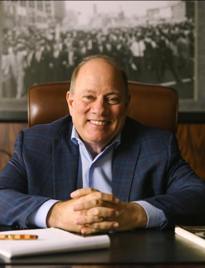Mike Duggan and a Brief History of Non-Major Party Michigan Gubernatorial Candidates
The Detroit mayor has an uphill battle to make a footprint in the 2026 contest

Two-term Secretary of State Jocelyn Benson and two-term Lieutenant Governor Garlin Gilchrist launched their campaigns this winter to lead the Democratic field while this week U.S. Representative John James entered the race as the early front-runner for the GOP nomination.
But the biggest curve ball that has been thrown into the mix at this early stage of the election cycle was the announcement late last year that Detroit Mayor Mike Duggan, a Democrat holding the nonpartisan office, would seek the state’s highest elected post as an independent.
Duggan has enjoyed double-digit support in early polling, but will voter interest in a non-major party candidate wane as Election Day draws nearer, as is so often the case for third party and independent campaigns?
Duggan will also have the non-trivial hurdle of achieving ballot access in the state. Michigan law requires a minimum of 30,000 valid signatures for nonpartisan statewide office hopefuls with at least 100 registered electors in each of at least half of the congressional districts in the state.
While Michigan has enjoyed a fairly rich history of third party candidates achieving ballot access in campaigns for governor and other prominent offices, this has not been the case for independents.
Since 1835, there have been 186 candidates on Michigan gubernatorial general election ballots who were not nominees of the two major parties of their day (Democratic, Whig, and Republican).
Only one of these candidates ran ostensibly as an independent.
In 1982, Shiawassee County Drain Commissioner Robert Tisch ran under the “Tisch Independent Citizens Party” label. Tisch won 2.6 percent and placed third in a seven candidate field won by Democratic congressman Jim Blanchard.
[There also have been only two U.S. Senate candidates without party affiliation in Michigan electoral history: Flint attorney and Lyndon LaRouche-ite Max Dean in 1984 and Northwest airlines ground services employee Mark Friedman of Detroit in 1988 (who was a member of the Socialist Workers Party)].
Over the decades, at least one third party candidate has appeared on a Michigan gubernatorial ballot in 65 of the 81 contests since statehood. [Only major party candidates ran in 1835, 1837, 1839, 1849, 1851, 1854, 1856, 1858, 1860, 1862, 1864, 1866, 1868, 1978, 1994, and 1998].
However, just three of these 186 candidates have received double-digit support come Election Day – and two of those entered the race as sitting Republican elected officials:
- 1872: Republican U.S. Representative and former Governor Austin Blair – running under the Liberal Republican banner (36.4 percent). [Blaire was also nominated by the Democratic Party, while the ‘Straight Democrats’ nominated Col. William Ferry].
- 1878: Greenbacker and Grand Rapids Mayor Henry Smith (25.9 percent)
- 1912: Republican State Senator Lucius Watkins of Manchester – running as a Progressive (28.3 percent)
The third party that has fielded the most candidates for governor over the decades is the Prohibition Party (42 cycles) followed by Socialist Labor (31), Socialist (23), Socialist Workers (10), Communist (six), Libertarian (six), U.S. Taxpayers (six), Green (six), Liberty (five), and American (four).
The Greenback and People’s Party also each ran four stand-alone nominees plus ran on a fusion ticket with the Democrats in multiple cycles during the late 19th Century.
Michigan has been home to several short-lived parties that fielded candidates for as few as one cycle such as Proletarian (1932), People’s Progressive (1934), Square Deal (1938), Protestants United (1938), America First (1944), Tax Cut (1960), Independent American (1960), and Freedom Now (1964).
The average support for a third party candidate in Michigan gubernatorial elections has been just 1.5 percent.
Follow Smart Politics on X.
